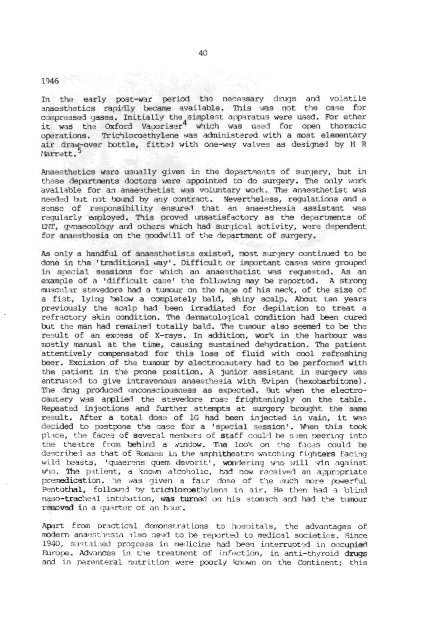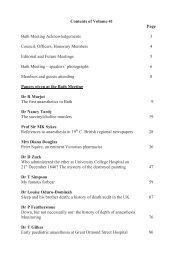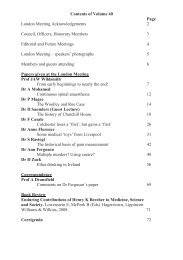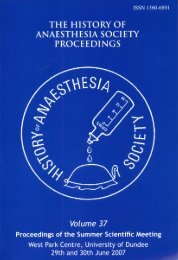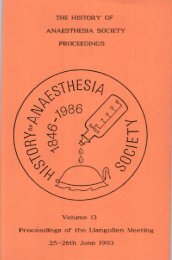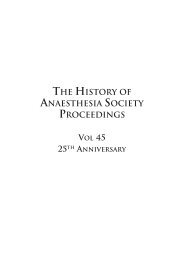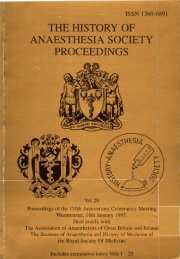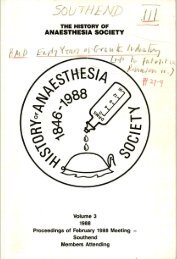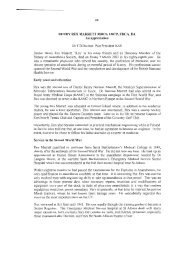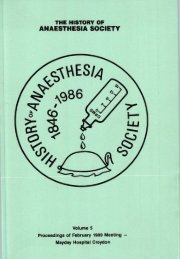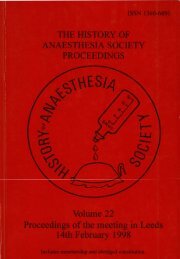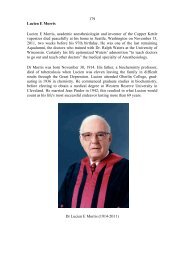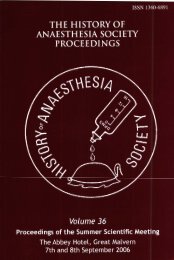3 - History of Anaesthesia Society
3 - History of Anaesthesia Society
3 - History of Anaesthesia Society
Create successful ePaper yourself
Turn your PDF publications into a flip-book with our unique Google optimized e-Paper software.
In the early pst-mr perid the necessary drugs and volatile<br />
anaesthetics rapidly became available. Tnis :ms not the case for<br />
compressed gases. Initially the simplest app-ratus were used. For ether<br />
it was the Oxford vaoorisor4 which w.as used for ocen thoracic<br />
operations. Tric'7loroethylene was administered with a mst elementary<br />
air draw-over bottle, fittail with one-way valves as designed by H R<br />
~tarrztt.~<br />
Anaesthetics were usually given in the deprtments <strong>of</strong> surylery, but in<br />
th-se deprtments doctors were apyinted to do surgery. The only work<br />
available for an anae5thstist was voluntary work. The ansesthetist was<br />
needed hlt not b~md by any contract. Nevert5eless. recplations and a<br />
sense <strong>of</strong> responsibility ensured that an anaesthesia assistant was<br />
reqularly employed. This proved unsatisfactory as the departments <strong>of</strong><br />
El?'l', gvnaecoloq.] and others which had surqicsl activity, were dependent<br />
for anaesthesia on t'le qoodwill <strong>of</strong> the department <strong>of</strong> surgery.<br />
As only a handful <strong>of</strong> anaesthetists existed, mst sllrOery continued to be<br />
done in t'le 'tradition31 my1. Difficult or imprtant cases were pupd<br />
in special sessions for which an anaesthetist was requested. Rs an<br />
example <strong>of</strong> a 'difficult case' the follaqing may be renortd. A strong<br />
muscular stevedore had a tumour on the na,p <strong>of</strong> his neck, <strong>of</strong> the size <strong>of</strong><br />
a fist, lying ?elm a canpletely bld, shiny scalp. Abut ten years<br />
previously the scalp had been irradiated for depilstion to treat a<br />
refractory skin condition. The demtolgical condition had been cured<br />
but the man had remind totally bald. The twour also seemed to be the<br />
result <strong>of</strong> an excess <strong>of</strong> X-rays. In addition, wor'c in the harbour was<br />
mostly mnual at the time, causing sustained dehydration. The patient<br />
attentively canpensated for this loss <strong>of</strong> fluid with cool refreshing<br />
beer. Excision <strong>of</strong> the tumour by electrocautery had to be performed with<br />
the patient in the prone position. A junior assistant in surgery was<br />
entrusted to give intravenous anaesthesia with Evip (hexobarbitone).<br />
l3e drug prhced ~lnconsciousness as expzted. l3ut when the electrocautery<br />
was applied the st2vedore ros? frighteningly on the table.<br />
Repeated injections and further attempts at surgery brought the saw<br />
result. After a total dose <strong>of</strong> 1G had been injected in vain, it was<br />
decided to postpne t5e case for a 'special session'. Wen this took<br />
plqce, the faces <strong>of</strong> several members <strong>of</strong> staEE could be seen peering into<br />
the t'leatre from behind a dindow. Tile look on the faces could be<br />
described as that <strong>of</strong> Wnrcins in the amphitheatre watching fighters facing<br />
wi-ld teas ts, ' quaerens quem devoritl , wondering w'lo will .#in against<br />
\++a>. The pWient, a known alcoholic, had now received an appropriats<br />
premedication. '~e ;gas given a fair dose <strong>of</strong> the lruch mre powerful<br />
Pentothal, follov~~? by trichloroet!iylens in air. He then had a blind<br />
naso-tracheal inttihation, was turncd on his stomach and had the tumur<br />
renoved in a qudrter <strong>of</strong> an hour.<br />
Aprt from prlctical demonstrations to hosi>itals, the advantages <strong>of</strong><br />
modern ana~?st:~esia 3ls0 ne?d to be rep~rted to medical societies. Since<br />
1940, surtsi.~eJ progress in me;licine had been interrupt,-4 in occupied<br />
Europe. Advances in the treatment <strong>of</strong> inf~xtion, in anti-thymid drugs<br />
and in parenteral nutrition were poorly known on the Continent; this


